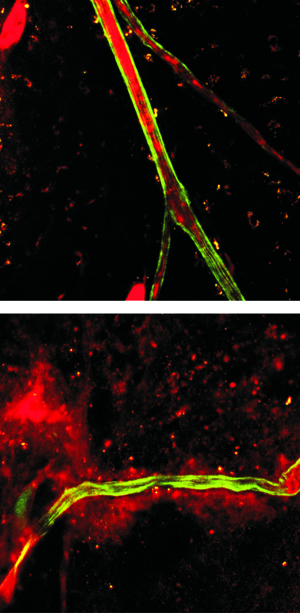
September 1, 2009
LA JOLLA, CA—Protein S, a well-known anticoagulant protein, keeps the blood flowing in more than one way, discovered researchers at the Salk Institute for Biological Studies. The protein contributes to the formation and function of healthy blood vessels.
The researchers found that mice lacking protein S suffered massive blood clots, but also had defective blood vessels that allow blood cells to leak into the surrounding tissue.

Top Image: An inert red dye injected into the circulation of normal mice remains confined within blood vessels (green) of the brain.
Bottom Image: The same red dye injected into the circulation of mice with a 50% reduction in the level of Protein S leaks out of brain vessels (green) and leaches into the surrounding brain tissue.
Image: Courtesy of Tal Burstyn-Cohen
“We had anticipated finding clotting problems, but the prominent role of protein S in the development and maintenance of blood vessels was completely unexpected,” says first author Tal Burstyn-Cohen, Ph.D., a former post-doc in the Molecular Neurobiology Laboratory and now at the Department of Ophthalmology, Hadassah Medical Center, Jerusalem, Israel.
There are more than 200 known human mutations and polymorphisms in the gene coding for protein S, which was arbitrarily named after Seattle, the city of its discovery. The resulting deficiencies predispose carriers to deep venous thrombosis, strokes at an early age, recurrent miscarriages, and pre-eclampsia, and are associated with several autoimmune diseases, most prominently systemic lupus erythematosus.
“Protein S is a really interesting molecule,” says Greg Lemke, Ph.D., a professor in the Salk’s Molecular Neurobiology Laboratory, who led the study, which appears in the Sept. 1, 2009, issue of the Journal of Clinical Investigation. “During the course of evolution, it was co-opted from the coagulation cascade for the regulation of inflammation in the immune system.”
The moment a blood vessel is breached, the coagulation cascade activates a series of enzymes in domino-like fashion, which allows the rapid formation of a plug at the site of injury. As part of a carefully calibrated system of checks and balances, Protein S aids with the inactivation of clotting factors Va and VIIIa, preventing excessive clotting.
In patients who are born with two abnormal copies of the protein S gene, a severe form of thrombosis called purpura fulminans can result. This life-threatening condition involves severe clotting throughout much of the body, ultimately causing death to the tissues.
But Protein S also binds to and activates a trio of receptors, Tyro3, Axl, and Mer, which are collectively known as TAMs. Apart from being involved in a host of cellular processes, the TAMs most famously act as a molecular “trip switch” that prevents the immune system from spiraling out of control and turning against one’s own body.
Though protein S’s dual role in coagulation and inflammation is one that scientists have known about for years, its exact function has remained a mystery. Lemke and Burstyn-Cohen, wanting to understand the molecular details, created knockout mice missing the ProS1 gene, which encodes protein S.
“It was the last gene encoding a critical component of the blood coagulation cascade to be inactivated in mice,” says Burstyn-Cohen, “and the resulting phenotype is probably the most severe of them all.” Mice without functional protein S die in utero with massive consumptive blood clots, which soak up all available clotting factors, causing severe hemorrhaging elsewhere.
In addition to blood clots, these mice also had problems with vascular integrity and the functioning of these blood vessels. “TAM receptors are important for maintaining the physiological integrity of the smooth muscles that line blood vessels,” explains Burstyn-Cohen. “Without protein S the muscle layer is disordered, and the vessels become leaky.”
Like other components of the clotting cascade, most of the circulating protein S is produced by hepatocytes in the liver, or so it was thought. When Burstyn-Cohen shut down the production of protein S in hepatocytes, however, levels of protein S only dropped by half. A closer look revealed that the endothelial cells lining blood vessels themselves provided most of the remaining protein.
“Blood clotting disorders are a good target for gene therapy since the absence of a single factor can sabotage the body’s ability to stanch bleeding or stop the coagulation process,” says Lemke. “Our findings suggest that in addition to hepatocytes, endothelial cells, which are easily accessible via the circulatory system, may be a particularly good target for gene therapy to correct genetic or acquired defects in ProS or other regulators of blood coagulation.”
For information about the commercialization of this technology, please contact the Salk Office of Technology Development, (858) 453-4100, Ext. 1278.
This work was supported by the National Institutes of Health, grants from the Lupus Research Institute, the Stein Endowment Fund, and the Hoffman Foundation.
Mary Jo Heeb, Ph.D., in the Department of Molecular and Experimental Medicine at The Scripps Research Institute, La Jolla, also contributed to this work.
About the Salk Institute for Biological Studies:
The Salk Institute for Biological Studies is one of the world’s preeminent basic research institutions, where internationally renowned faculty probe fundamental life science questions in a unique, collaborative, and creative environment. Focused on both discovery and mentoring future generations of researchers, Salk scientists make groundbreaking contributions to our understanding of cancer, aging, Alzheimer’s, diabetes, and cardiovascular disorders by studying neuroscience, genetics, cell and plant biology, and related disciplines.
Faculty achievements have been recognized with numerous honors, including Nobel Prizes and memberships in the National Academy of Sciences. Founded in 1960 by polio vaccine pioneer Jonas Salk, M.D., the Institute is an independent nonprofit organization and architectural landmark.
Office of Communications
Tel: (858) 453-4100
press@salk.edu